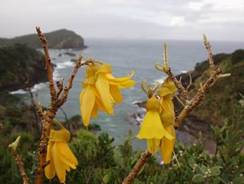Introduction
Northland region with its subtropical affinities, oceanic climate and wide variety of habitat types has an unusually high diversity of plants and animals including many species found nowhere else. Although more than 80% of these habitats have been modified or lost most of the remaining natural habitats, although fragmented, still have high biodiversity values and contribute to the natural character of the region. These high biodiversity values are also at risk from the large number of pest plants and animals that are present in Northland.
 Kowhai tree in bloom.
Kowhai tree in bloom.
As the management authority for pest plant and animals the Council is responsible for locating and controlling pests targeted in the Northland Regional Pest Management Strategies under the Biosecurity Act 1993. The Council's goal is to prevent potential pests from entering the region, as well as to manage existing targeted pest infestations to levels where they no longer pose a threat to natural ecosystems, primary production, and animal and human health. In 2005-2006 the Biosecurity team worked towards the many performance targets set out in the Long Term Council Community Plan under Biosecurity Management.
In 2005-2006 the Regional Council Biosecurity team responded to 992 enquiries in relation to pest management. Biosecurity staff also carried out monitoring and/or control of:
- Pest invertebrates including guava moth, tropical grass webworm, gum leaf skeletoniser and pest ants;
- Animal pests including possums, mustelids, cats and rats and,
- Pest plants including gorse, ragwort, bridle creeper, African feathergrass, lantana, Manchurian ricegrass, nassella tussock, spartina, Bathurst bur, Californian thistle and nodding thistle.
